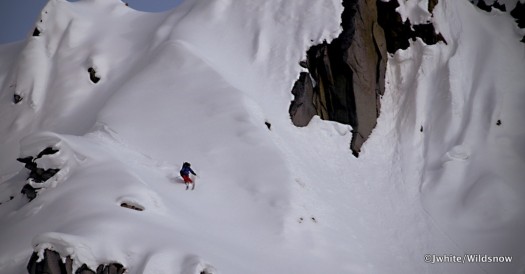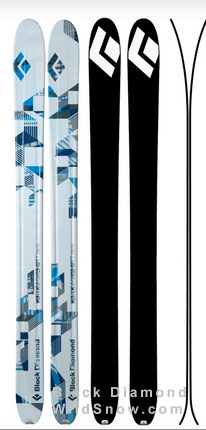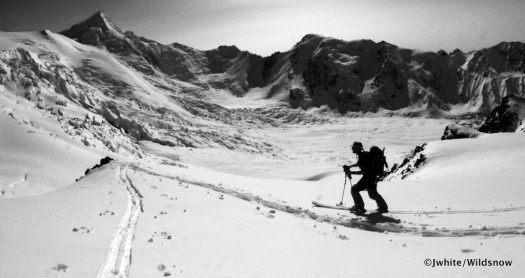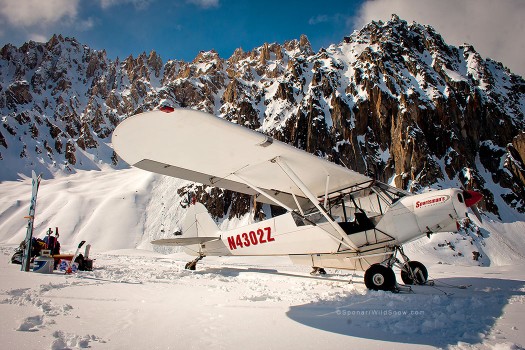
Anton testing the Black Diamond Carbon Megawatts, Tordrillo Mountains, Alaska.
By the time April rolled around this year in the western United States I was acutely aware that I could count the number of powder days I had on one hand. Needless to say I had the itch.
Lucky for me I have friends who happened to have time and a few extra bucks for scratching. So Jordan, Matt, Brad and I jumped on a plane to Anchorage, Alaska, and then flew a much smaller plane into the Tordrillo Range. Accompanying me on this trip were a pair of Black Diamond Carbon Megawatt skis. I spent the next three weeks on the Hayes Glacier seeing what those planks could do for backcountry skiing adventure.

Black Diamond Carbon Megawatt 2012/13
Our plan was what I can only describe as “ski plane base camping.” After the aircraft set us down on the glacier we unloaded our mountain of gear and spent a day setting up a camp. For the next three weeks this was our home. Whenever the weather cooperated (which is about half of the time in AK) we set out to ski whatever looked fun.
The options were endless. But so were the approaches. During the infinite slogs I was beyond happy with my ski selection. The Carbon Megawatts I had weigh in at a mere 9 pounds 5 ounces a pair (188 cm). This helped turn the slogs into easy jaunts where I could enjoy the breathtaking scenery instead of work my rear off to simply keep up. We would then continue our journey across the crevasse fields that line the edge of the glacier and head up and up to our objective for the day. And then, down.

The options were endless -- but so were the approaches. Having light skis made it happen.
In previous years I have not been happy with the performance of the Black Diamond Megawatt. I have skied them in all conditions, both on the resort and in the backcountry. I overpowered them in most conditions. They felt floppy. With the introduction of carbon into the construction of the ski things have changed. After a few turns of my first run in the Tordrillos I could feel the difference. Essentially, these are an old-school Megawatt in name only — they should have called them Megawatt 2.0 or something to that effect.
Since it had not snowed in a while there was a pretty serious crust forming on all but the pure north facing slopes. I found this out the hard way after I took a few turns on a pure north face and then meandered over a bit. The difference was jarring, and I thought I was going into my first tomahawking session in Alaska. Didn’t happen. The Carbon Megawatts responded beautifully. I was able to power through the crust and regain control. Relieved and impressed is an understatement.

Backcountry skiing with aircraft access in Alaska.
In the middle of our time on the Hayes it began to dump the white crystals of water. About 6 days and 10 feet later, we came out into the sun ready to ski pow. And we did. A lot. In the steep powder spines, chutes and faces that we found to play on the Carbon Megawatts shined. With dimensions of 153-125-130, a 188 cm length, and a tip and tail rise with slight camber underfoot, I was living the dream. I could go as fast or slow as I wanted. I could slash turns, carve turns or simply pivot with ease. Being able to outrun my enormous sluffs was also a huge plus.
Not all was perfect though. There were times when we hit variable sections after the storm. One day we found ourselves having to ski a wind hammered section bordered by seracs. The wind had stripped all the new snow away and left a very firm section for us to ski. I chalked it up as a grip test for the powder hungry Megawatts. In my opinion they passed. I can’t say with a straight face that a super light 125 underfoot rockered ski completely preformed on the hardpack. But while these are definitely not an “edgehold ski” I wasn’t wondering if they would grab or if I would slide to my demise amongst the seracs. In fact, there was a decent amount of snap coming out of the turns that pleasantly surprised me. I was actually able to ski with confidence.
I’m sold. Carbon Megawatts preformed as I had hoped they would. For human powered powder skis these planks are at the top of my list. I can’t wait to get out and play with them in Colorado once the snow starts flying again.
Shop for Black Diamond Carbon Megawatt
(WildSnow.com guest blogger Anton Sponar spends winters enjoying the skiing ambiance of the Aspen area, while summers are taken up with slave labor doing snowcat powder guiding at Ski Arpa in Chile. If Anton didn’t ski every month of the year, backcountry skiing would cease to exist as we know it. Also, thanks Jordan White for the terrific photos. Jordan blogs over at elksandbeyond.com)
WildSnow.com guest blogger Anton Sponar spends winters enjoying the Aspen area of Colorado, while summers are taken up with slave labor doing snowcat powder guiding at Ski Arpa in Chile. If Anton didn’t ski every month and nearly every week of the year, skiing would cease to exist as we know it.
